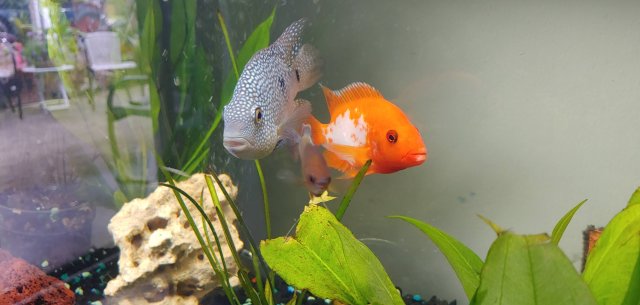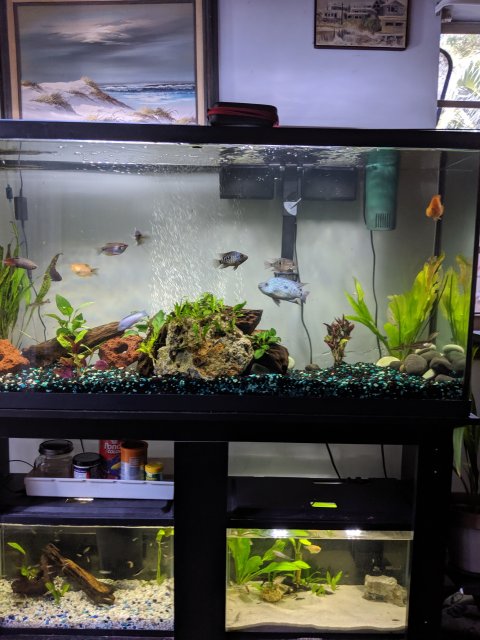Great input!?.. It's crazy how there's video's and threads out there of jaguar cichlids possibly being mellow or not at all aggressive as one many say they are - with other cichlids. Makes you question if there species are missed understood (Not the dovii)..
Overstocking to lessen aggression (American cichlids)?
- Thread starter Predator07
- Start date
You are using an out of date browser. It may not display this or other websites correctly.
You should upgrade or use an alternative browser.
You should upgrade or use an alternative browser.
Great input!?.. It's crazy how there's video's and threads out there of jaguar cichlids possibly being mellow or not at all aggressive as one many say they are - with other cichlids. Makes you question if there species are missed understood (Not the dovii)..
There are definitely tanks out there where people attempt to comm parachromis and there are quite a few documented on this forum. Ive done quite a bit of research because this kind of tank interests me as well. Theres a member,
MONSTER GUAPOTE COMMUNITY UPDATE...
I've been M.I.A. for a while with some health problems. Probably a lot of new guys who don't know me and what I do since the last time I was here. Check the sig line. The good news is everything has been the same old same old in the big tank. I haven't been able to keep up with water changes...
Bottom line from my perpective is that it takes a large tank (300+ gallons) and an intricate knowledge of every species in the tank to make it work, as well as a backup plan if it doesnt.
Heres an almost identical thread to yours from almost ten years ago with a lot of advice from now old timers here.
Does slight overcrowding spread aggression.
Hey all. Just trying to get some juveniles together in a 55gal tank that is getting upgraded in two months to a 100gal. Have heard that adding more fish rather than less can be an effective way of spreading the aggression. Is this true or just a myth?
As of now- In a grow out tank of 150gallon : I have 3inch JD, Gt, vieja (redhead) and 3.5-4inch Oscar and Midas and also chocolate cichlid at 7inch... im debating whether or not to add jag(2.5-3inch) or not... couple of months getting 300gallon tank...
I try to take tank stocking cues from life i nature if possible, although I realize a tiny tank is quite far from any nature reality.
In the video below Parachromis multifasciatus is the main aquatic predator in the littoral zone.
In the Mexican Cenote, are the tetra Astyanax, the live bearer, Poecilia, Parachromis multifasciatus, and some introduced Tilapines.
The predator to prey ratio, mimics many predator/prey situations throughout nature (like Wildebeast to Lion ratio in Africa)
Aktun Ha
I recommend turning the sound off so you don't have hear me constantly clearing my snorkel.
In the video below Parachromis multifasciatus is the main aquatic predator in the littoral zone.
In the Mexican Cenote, are the tetra Astyanax, the live bearer, Poecilia, Parachromis multifasciatus, and some introduced Tilapines.
The predator to prey ratio, mimics many predator/prey situations throughout nature (like Wildebeast to Lion ratio in Africa)
Aktun Ha
I recommend turning the sound off so you don't have hear me constantly clearing my snorkel.
As of now- In a grow out tank of 150gallon : I have 3inch JD, Gt, vieja (redhead) and 3.5-4inch Oscar and Midas and also chocolate cichlid at 7inch... im debating whether or not to add jag(2.5-3inch) or not... couple of months getting 300gallon tank...
Personally, i would not add a parachromis to that mix. None of those fish possess the attitude or weapons to compete with a jag over territory.
It might be fine when theyre all small but once theyve matured i see a lot of those fish becoming carcasses and the rest constantly hiding in fear, even in a 300.
Agree with this, all but the Vieja and JD in your list, are South American cichlids which come from an entirely different and less aggressive attitude type place.Personally, i would not add a parachromis to that mix. None of those fish possess the attitude or weapons to compete with a jag over territory.
It might be fine when theyre all small but once theyve matured i see a lot of those fish becoming carcasses and the rest constantly hiding in fear, even in a 300.
Most South American cichlids live in varied communities, that allow for multiple combinations to occur naturally, they seem more tolerant in community situations.
I prefer to keep South American, and Central American cichlids in separate tanks for this, and other reasons (like water chemistry preferences.
Central American waters are often home to only a few species (like my video above) or other waters I've spent time in, and find even in nature, JDs often suffer when in the presence of other more dominant cichlids.
In the 1st video below, JDs dominate the cichlid landscape, are plentiful and other species are either live bearers, or a relatively small population of Rhamdia catfish.
Eden2
But below in a Cenote where another more dominant cichlid is found, (Mayaheros uropthalmus), there are few JDs, and they are a bit torn up.
027 zps4b102ffd
Last edited:
The only CA cichlids that do well by crowding are thorichthys, like meeki.
Tank size is every thing with this topic. George Barlow said that amphilophus citrinellus lived in large lose groups around rocky out crops with very little aggression. Other large aggressive species are similar, urophthalmus, some of the vieja, and most of the other amphilophus spp. In the wild the natural roaming range of these species might be 1000's of sq/m around the centre of the outcrop, aggression only becomes a problem when we reduce this to 2sq/m and expect it to share with what ever takes our fancy.
Look at some of the dovii and suchlike in public aquariums, swim about like little puppy dogs.
Most community tanks I have seen end in disaster or a never ending cycle of moving stock around trying to keep the balance.
Look at some of the dovii and suchlike in public aquariums, swim about like little puppy dogs.
Most community tanks I have seen end in disaster or a never ending cycle of moving stock around trying to keep the balance.
I’ve always tried keeping multiple centrals in my tank and success seems to vary by the individual fishes. Anything can happen, but because they get so large I don’t think it work work well with overstocking. Eventually they will assert themselves for territory. I have a 220, and I never start with more than 5-6, and usually try to limit the amount of serial murderers like Jags, Dovii, Motas, Red Devils, and the like. Maybe one of those with a few other smaller or less punchy Centrals.




